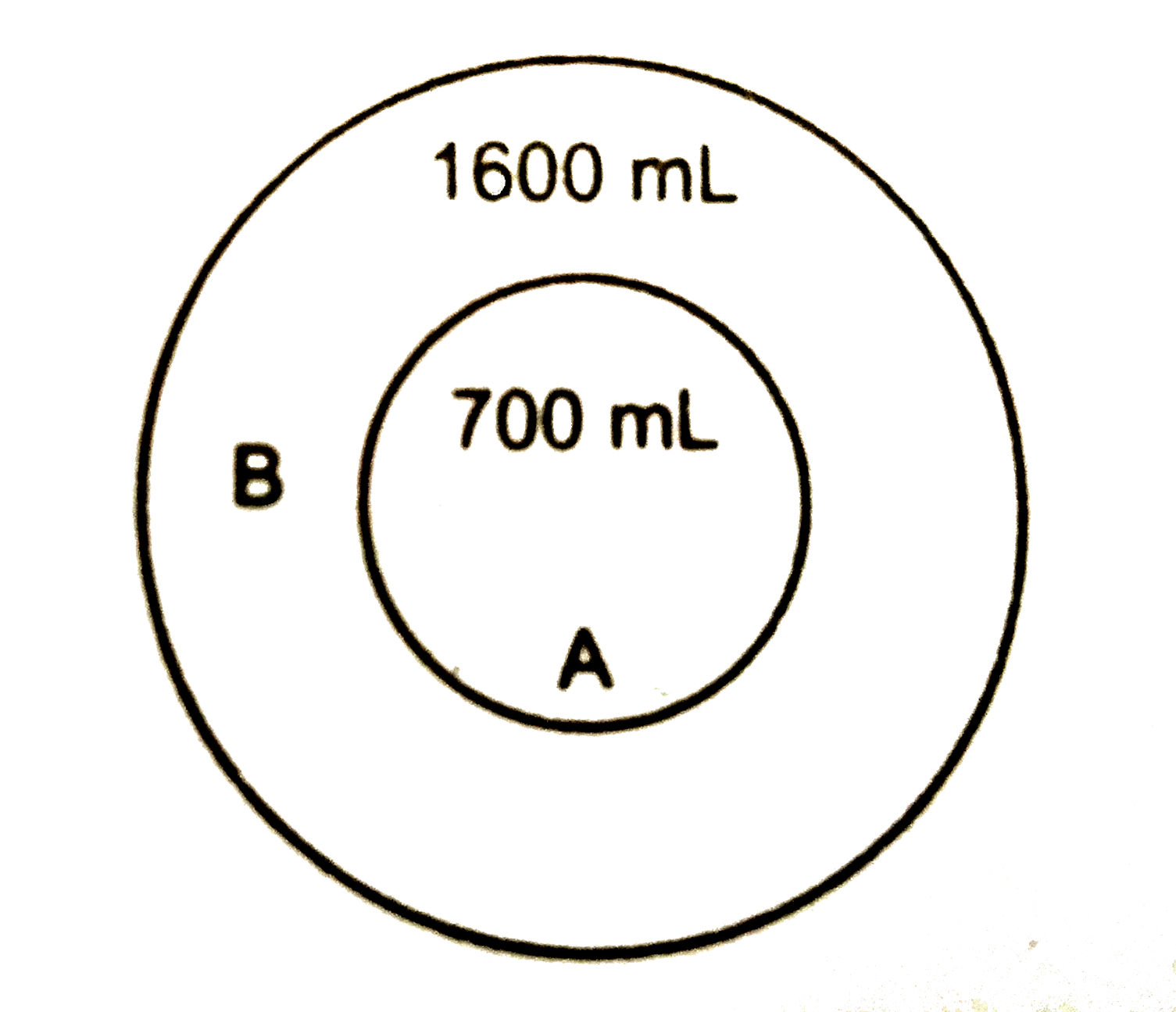Two inflated ballons I and II (thin skin) having volume 600 mL and 1500 mL at 300 K are taken as shown in diagram. If maximum volume of inner and outer balloons are 800 mL and 1800 mL respectively then find the balloon which will burst first on gradual heating.

inner balloon
outer balloon
both simultaneously
unpredictable
The correct Answer is:b
(b) Case I− Suppose inner balloon burst first first
600300=800T2⇒T2=400K
Case II−Suppose inner balloon burst first
1500300=1800T2, T2=360K
Topper's Solved these Questions
- GASEOUS STATEBOOK - NARENDRA AWASTHICHAPTER - GASEOUS STATEEXERCISE - Level 1 (Q.31 To Q.60)
1 Video
- GASEOUS STATEBOOK - NARENDRA AWASTHICHAPTER - GASEOUS STATEEXERCISE - Level 1 (Q.121 To Q.150)
1 Video
- ELECTROCHEMISTRYBOOK - NARENDRA AWASTHICHAPTER - ELECTROCHEMISTRYEXERCISE - Level 3 - Subjective Problems
1 Video
- IONIC EEQUILIBRIUMBOOK - NARENDRA AWASTHICHAPTER - IONIC EEQUILIBRIUMEXERCISE - Exercise
196 Videos
Similar Questions
The molar volumes of KCl and NaCl are 40mL and 30mL, respectively. Find the ratio of the unit cube edges of the two crystals. Assume both have the same packing efficiency.
View SolutionA blown-up balloon has a volume of 500 mL at 5∘C . The balloon is distended to 7/8 of its maximum stretching capacity. Will the balloon burst at 30∘C? Determine the minimum temperature above which it will burst.
View Solution
Knowledge Check
Two balloon A and B are taken at 300 K. Maximum capacity of balloon A and balloon B are 800 mL and 1800 mL respectively. When the balloon system is heated, which one will burst first ?
 AInner balloon ABOuter balloon BCBoth balloon's simultaneouslyDcannot be predicted
AInner balloon ABOuter balloon BCBoth balloon's simultaneouslyDcannot be predictedA bolloon blown up has a volume of 300 mL at 27% C. The balloon is distended to 56 of its maximum stretching capacity. The maximum temperature above which it will burst is
A77∘CB67∘CC57∘CD87∘CA reversible heat engine carries 1mol of an ideal monatomic gas around the cycle ABCA, as shown in the diagram. The process BC is adiabatic. Call the processes AB,BC and CA as 1,2 and 3 and the heat (ΔQ)r, change in internal energy (ΔU), and work done (ΔW)r,r=1,2,3 respectively. The temperature at A,B,C are T1=300K,T2=600K and T3=455K. Indicate the pressure and volume at A,B andC by Pr and Vr,r=1,2,3, respectively. Assume that intially pressure P1=1.00atm.
Suppose the gas had been taken along an isothermal process from B instead of along the adiabatic process BC shown, so as to reach the same volume V3, and the total heat Q1 is taken during the complete cycle involving the isothermal, while Qa is the total heat taken in the cycle ABCA shown in the diagram. ThenAQi<QaBQi=QaCQi>QaDQi will be greater or less than Qa dependng upon the value of T3
A ballon blown up with 1 mole of gas has a volume of 480mL at 5∘C The balloon is filled to (7/8) th of its maximum capacity Suggest
(a) Will the balloon burst at 30∘C
(b) The minimum temperature at which it will burst
(c ) The pressure of gas inside the balloon at 5∘C
(d) The pressure of gas when balloon bursts .
View SolutionOn the surface of the earth at 1 atm pressure, a balloon filled with H2 gas occupies 500mL. This volume is 56 of its maximum capacity. The balloon is left in air. It starts rising. The height above which the balloon will burst if temperature of the atmospere remains constant and the pressure decreases 1 mm for every 100cm rise of height is:
View SolutionTwo gases H2 and CO2 are taken 1mol and 2mol respectively in a container of volume 100ml at 400K. Find pressure of the mixture
View SolutionA gaseous system is initially characterised by 500 mL volume and 1 atm pressure at 298 K. This system is allowed to do work as
In isobaric conditions it expands to 800 mL resulting a decrease in pressure and temperature to 0.6 atm and 273 K respectively.
(ii) In adiabatic conditions it is allowed to expand upto 800 mL and results a decrease in pressure and temperature to 0.6 atm and 273 K respectively.
If Gibbs energy change in (i) is ΔGa and in (ii) is ΔGb, then what will be the ration of ΔGaΔGb?
View SolutionOn the surface of the earth at 1 atm pressure, a balloon filled with H2 gas occupies 500mL. This volume is 56 of its maximum capacity. The balloon is left in air. It starts rising. The height above which the balloon will burst if temperature of the atmospere remains constant and the pressure decreases 1 mm for every 100cm rise of height is:
View Solution
